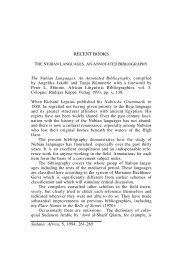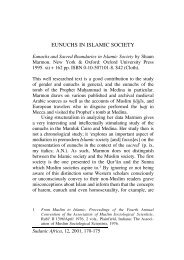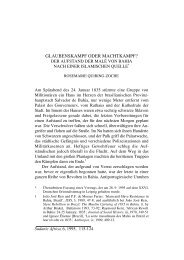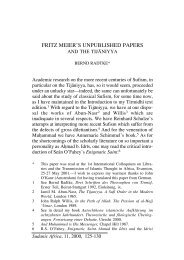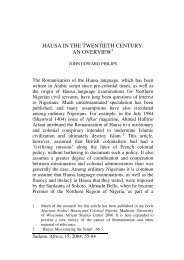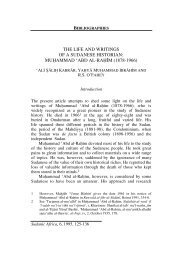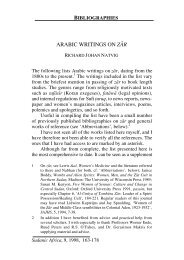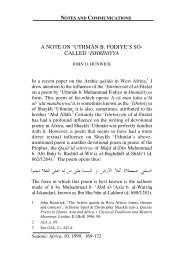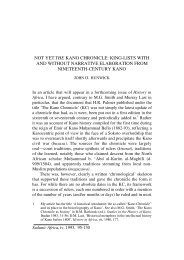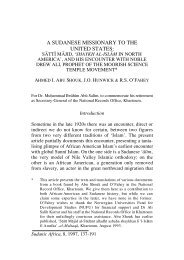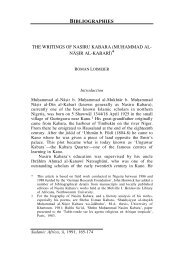Muslim Women's Quest for Equality: Between Islamic Law and ...
Muslim Women's Quest for Equality: Between Islamic Law and ...
Muslim Women's Quest for Equality: Between Islamic Law and ...
Create successful ePaper yourself
Turn your PDF publications into a flip-book with our unique Google optimized e-Paper software.
Critical Inquiry / Summer 2006 635collapse of the Pahlavi regime, announced the restoration of sharia familylaw through the dismantling of the Family Protection <strong>Law</strong> <strong>and</strong> the reinstatementof the fiqh provisions <strong>for</strong> marriage <strong>and</strong> divorce (codified in 1935as part of the Iranian Civil Code). 8 The Family Protection <strong>Law</strong> of 1967 (<strong>and</strong>its 1975 amendments) had abolished men’s right to talaq (repudiation), restrictedtheir right to polygamy, <strong>and</strong> placed men <strong>and</strong> women on more orless the same legal footing in terms of access to divorce <strong>and</strong> custody rights.Khomeini’s office in 1979 restored the sharia in order to “protect the family”<strong>and</strong> realize women’s “high status” in Islam.But this was not how women perceived <strong>and</strong> experienced the changes. InOctober 1980, when I first started attending the Tehran branches of the newfamily courts, now presided over by <strong>Islamic</strong> judges, women who came tocourt were astonished to learn that their husb<strong>and</strong>s could now divorce themwithout first securing their consent. Some remained incredulous<strong>and</strong>wouldask more than one judge: Can he really divorce me, if I don’t agree? Is thiswhat the sharia says? In 1985, when I resumed my court attendance,women,although no longer incredulous, were insistent on voicing their discontent;some used every occasion to remind the <strong>Islamic</strong> judge of his role as custodianof the sharia <strong>and</strong> of the injustice of a system which could af<strong>for</strong>d themno protection. It was common to hear women ask the judge, Is this howIslam honors women? Is this the justice of Islam, that he can dispose of menow that I have lost my youth <strong>and</strong> replace me with a younger wife? To thesequestions, the judges had no answer, especially when a man insisted on exercisinghis right to divorce a wife who was entirely dependent upon him,with no other source of income <strong>and</strong> nowhere else to go. Some judges—though certainly not all—experienced a moral dilemma. Not only did theyhave to witness the plight of women on a daily basis, but they could nothelp but feel implicated themselves. The <strong>Islamic</strong> judges in whose courts Isat in the 1980s often told me that I had chosen the wrong place to learnabout the sharia. I should to go to the seminaries, they said, to read fiqhtexts <strong>and</strong> discuss them with the ulama; the courts had nothing to teach meabout the sharia.In 1997, when I returned to the Tehran courts to make a documentaryfilm about divorce, 9 there was little trace of the idealism I had encounteredin the 1980s. Meanwhile, the en<strong>for</strong>cement of patriarchal fiqh notionsofmarriage<strong>and</strong> divorce had created such havoc in family life, such an uproaramong women, that the government had been <strong>for</strong>ced to restore almost all8. See In the Shadow of Islam: The Women’s Movement in Iran, ed. Azar Tabari <strong>and</strong> NahidYeganeh (London, 1982), p. 232.9. The name of this film is Divorce Iranian Style, dir. Mir-Hosseini <strong>and</strong> Kim Longinotto(London, 1998).



